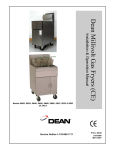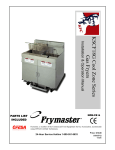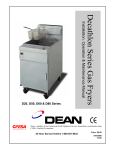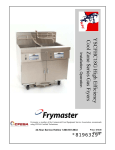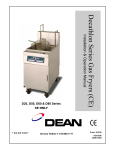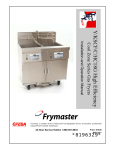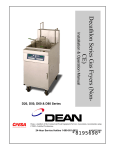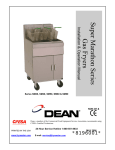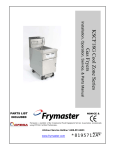Download Frymaster 52 Series Fryer User Manual
Transcript
Super Runner 52 Series Gas Fryers Installation & Operation Manual & DOMESTIC PARTS LIST INCLUDED Dean, a member of the Commercial Food Equipment Service Association, recommends using CFESA Certified Technicians. 24-Hour Service Hotline 1-800-551-8633 Price: $8.00 819-5784 MARCH 2002 Please read all sections of this manual and retain for future reference. Installation, maintenance, and repairs should be performed by your Dean Factory Authorized Service Center. CAUTION Do not store or use gasoline or other flammable vapors and liquids in the vicinity of this or any other cooking appliance. CAUTION Instructions explaining procedures to be followed MUST be posted in a prominent location in the event the operator detects a gas leak. This information can be obtained from the local gas company or gas supplier. WARNING Improper installation, adjustment, alteration, service or maintenance can cause property damage, injury or death. Read the installation, operating and maintenance instructions thoroughly before installing or servicing this equipment. WARNING Safe and satisfactory operation of your equipment depends on proper installation. Installation MUST conform with local codes, or in absence of local codes, with the National Fuel Gas Code, ANSI Z223.1; The Natural Gas Installation Code, CAN/CGAB149.1; or The Propane Installation Code, CAN/CGA-B149.2. NOTICE The Commonwealth of Massachusetts requires any and all gas products to be installed by a licensed plumber or pipe fitter. Australia Only Keep the oil temperature in the fryer to a maximum of 190°C. Higher temperatures will cause rapid breakdown of the oil and give you no faster cooking. At 205°C to 210°C the life of the oil is only one-third of its life at 190°C. In addition, increased decomposition causes the oil to smoke badly even if the temperature is lowered to 190°C again. High temperatures give you no advantage, costs you money and increases the fire danger. i SUPER RUNNER 52 SERIES GAS FRYERS TABLE OF CONTENTS Page # 1. INTRODUCTION 1-1 2. IMPORTANT INFORMATION 2-1 3. INSTALLATION INSTRUCTIONS 3-1 4. DAILY OPERATION 4-1 5. PREVENTATIVE MAINTENANCE 5-1 6. TROUBLESHOOTING 6-1 7. PARTS LIST 7-1 ii SUPER RUNNER 52 SERIES GAS FRYERS CHAPTER 1: INTRODUCTION 1.1 Ordering Parts Customers may order parts directly from their local Authorized Parts Distributor. For this address and phone number, contact your maintenance and repair center or call the factory. The factory address and phone numbers are on the back cover of this manual. To speed up your order, the following information is required: Model Number Serial Number Optional Equipment Item Part Number Type Quantity Needed 1.2 Service Information Call the 1-800-551-8633 or (318) 865-1711 Service Hotline number for the location of your nearest maintenance and repair center. Always give the model and serial numbers of your fryer. To assist you more efficiently, the following information will be needed: Model Number Serial Number Optional Equipment Nature of Problem Type Additional information (i.e. cooking environment, time of day, and other pertinent information) may be helpful in solving your service problem. Communicate with your service technician. 1-1 1.3 Safety Information Before attempting to operate your unit, read the instructions in this manual thoroughly. Throughout this manual, you will find notations enclosed in double-bordered boxes similar to the ones below. CAUTION boxes contain information about actions or conditions that may cause or result in a malfunction of your system. CAUTION Example of a CAUTION box. WARNING boxes contain information about actions or conditions that may cause or result in damage to your system, and may cause your system to malfunction. WARNING Example of a WARNING box. DANGER boxes contain information about actions or conditions that may cause or result in injury to personnel, and may cause damage to your system and/or cause your system to malfunction. DANGER Hot cooking oil causes severe burns. Never attempt to move a fryer containing hot cooking oil or to transfer hot cooking oil from one container to another. 1-2 SUPER RUNNER 52 SERIES GAS FRYERS CHAPTER 2: IMPORTANT INFORMATION 2.1 General Dean Super Runner 52 Series gas fryers are energy-efficient, gas-fired units, design-certified by the CSA International (AGA/CGA), NSF International and manufactured to their basic performance and application specifications. All units are shipped completely assembled with accessories packed inside the fry vessels. All units are adjusted, tested and inspected at the factory before shipment. Sizes, weights and input rates of all models are listed in this manual. CAUTION The on-site supervisor is responsible for ensuring that operators are made aware of the inherent dangers of operating a hot-oil fryer/filter system, particularly the aspects of fryer operation, oil filtration, and draining/cleaning procedures. 2.2 Principles of Operation The incoming gas flows through orifices and is mixed with air in the burners to create the correct ratio for proper combustion. The mixture is ignited at the front end of each heat tube by the pilot light. Internal diffusers slow the flame as it goes through the burner tube. This slower and more turbulent flame gives much better heat transfer to the walls of the tubes, thereby heating the oil more efficiently. 2.3 Rating Plate This is attached to the inside right-hand corner of the front door panel. Information provided includes the model and serial number of the fryer, BTU/hr (kW/hr) of the burners, outlet gas pressure in inches W.C. (mbars) and whether the unit has natural or propane gas orifices. DANGER Fryers MUST be connected ONLY to the gas-type identified on the attached rating plate. CAUTION Local building codes usually prohibit a fryer with its open tank of hot oil from being installed beside an open flame of any type, whether a broiler or the open burner of a range. 2-1 2.4 Pre-Installation A. General: Only a licensed plumber should install any gas-fired equipment. 1. A manual gas shut-off valve must be installed in the gas supply line ahead of the fryers for safety and ease of future service. 2. Dean Super Runner Series gas fryers operate on millivolt, and do not require an external electric power supply. B. Clearances: The fryer area must be kept free and clear of all combustibles. This unit is design- certified for the following installations: 1. Commercial installation only (not for household use). 2. Non-combustible floor installation equipped with factory-supplied 6-inch (15-cm) adjustable legs or 5-inch (13-cm) casters; 3. Combustible construction with a minimum clearance of 6-inches (15-cm) side and 6-inches (15-cm) rear, and equipped with factory-supplied 6-inch (15-cm) adjustable legs or 5-inch (13-cm) casters. C. Installation Standards 1. CE/EXPORT STANDARDS: Fryer installation must conform with local codes, or in the absence of local codes, to the appropriate national or European Community (CE) standards. 2.5 Equipment Installed at High Altitudes A. The fryer input rating (BTU/hr) is for elevations up to 2,000 feet (610-m). For elevations above 2,000 feet (610-m), the rating should be reduced four-percent for each additional 1,000 feet (305-m) above sea level. B. The correct orifices are installed at the factory if the operating altitude is known at the time of the customer’s order. 2.6 Air Supply and Ventilation Keep the area around the fryer clear to prevent obstruction of combustion and ventilation airflow. A. Do not connect this fryer to an exhaust duct. B. Correct installation and adjustment will ensure adequate airflow to the fryer system. 2-2 2.6 Air Supply and Ventilation (cont.) C. A commercial, heavy-duty fryer must vent its combustion wastes to the outside of the building. A deep-fat fryer must be installed under a powered exhaust hood, or an exhaust fan must be provided in the wall above the unit, as exhaust gas temperatures are approximately 800-1000°F (427-538°C) . Check air movement during installation. Strong exhaust fans in the exhaust hood or in the overall air conditioning system can produce slight air drafts in the room. D. Do not place the fryer’s flue outlet directly into the plenum of the hood, as it will affect the gas combustion of the fryer. E. Never use the interior of the fryer cabinet for storage or store items on shelving over or behind the fryer. Exhaust temperatures can exceed 800°F (427ºC) and may damage or melt items stored in or near the fryer. F. Adequate distance must be maintained from the flue outlet of the fryer(s) to the lower edge of the filter bank. Per NFPA Standards No. 96, a minimum of 18-inches (45-cm) should be maintained between the flue(s) and the lower edge of the exhaust hood filter. G. Filters and drip troughs should be part of any industrial hood, but consult local codes before constructing and installing any hood. The duct system, the exhaust hood and the filter bank must be cleaned on a regular basis and kept free of grease. 2.7 Receiving and Unpacking Equipment A. Check that the container is upright. Use an outward prying motion - no hammering - to remove the carton. Unpack the fryer carefully and remove all accessories from the carton. Do not discard or misplace accessories. They will be needed. B. After unpacking, immediately check the equipment for visible signs of shipping damage. If damage has occurred, contact the carrier and file the appropriate freight claims. Do not contact the factory. Shipping damage responsibility is between the carrier and the dealer. If your equipment arrives damaged: 1. File claim for damages immediately, regardless of extent of damage. 2. Visible loss or damage: Be sure this is noted on the freight bill or express receipt and is signed by the person making the delivery. 3. Concealed loss or damage: If damage is unnoticed until equipment is unpacked, notify freight company or carrier immediately, and file a concealed damage claim. The claim should be filed within 15 days of date of delivery. Be sure to retain container for inspection. NOTE: Dean Does Not Assume Responsibility for Damage or Loss Incurred in Transit. 2-3 2.7 Receiving and Unpacking Equipment (cont.) C. Move the fryer to the location of installation and install legs and/or casters as described in Chapter 3.2. D. Remove all plastic skin from sides, front, and doors of the unit. Failure to do this will melt the plastic and make it very difficult to remove later. 2.8 Conversion of Units Pressure: 1 mbar = 10.2 mm water column (mm WC) = 0.4 Inch WC 20 mbar = 204 mm WC = 8 Inch WC 1-Inch W.C. = 25.4 mm WC = 2.5 mbar Heat Input: 1 kW = 3410 BTU/hr 100 BTU/hr = 0.293 kW Temperature: 0º Celsius = 32º Fahrenheit Temperature in degrees Celsius = (Temperature in degrees Fahrenheit (F) – 32) X 0.555 100° Celsius = (212º Fahrenheit – 32) X 0.555 2-4 SUPER RUNNER 52 SERIES GAS FRYERS CHAPTER 3: INSTALLATION INSTRUCTIONS 3.1 Installing the Fryer A. Initial Installation: If installed with legs, do not push against the fryer’s side to adjust its position. Use a pallet or lift jack to lift the fryer slightly and place it where it is to be installed. B. Relocating the Fryer: If relocating a fryer installed with legs, remove all weight from each leg before moving. Note: If a leg becomes damaged during movement, contact your service agent for immediate repair/replacement. CAUTION Fryers may not function properly if curb mounted. DANGER This fryer may tip and cause personal injury if not secured correctly in a stationary position. Drain all oil/shortening from fryer before moving. Hot oil will splash and cause severe burns upon contact. 3.2 Leg and Caster Installation A. General 1. Install legs and rear rigid casters near where the fryer is to be used, as neither are secure for long transit. Unit cannot be curb mounted and must be equipped with the legs and casters provided. 2. When positioning the fryer, gently lower the fryer into position to prevent undue strain to the legs and internal mounting hardware. Use a pallet or lift jack to lift and position the fryer if possible. Tilting the fryer may damage the legs. 3. The rigid casters must be installed on the fryer rear channel assembly only. 4. Proceed to Step 3.3, Leveling the Fryer, after legs and rear rigid casters are installed to ensure the fryer is level before using. 3-1 3.2 Leg and Caster Installation (cont.) B. Leg and Rigid Caster Installation 1. Remove unit from pallet. 2. Carefully raise unit with forklift, pallet jack, or other steady means. 3. Place one lock washer on each hex head screw. 4. Insert hex head screws with lock washers [1/4-20 threads by ¾" (19 mm) long] through bolt holes of leg mounting plates and mount to the front channel. Mount rigid casters to the rear channel following the same procedure. A locknut has been attached to the topside of the base mounting plates at the factory to capture the hex head screw as it is screwed in. 5. Tighten the bolts to 50 inch-lbs. (5.65 N m) minimum torque. CAUTION For caster retrofit, the unit must be at room temperature and drained of shortening before installing the casters. 3.3 Leveling the Fryer A. Place a spirit level across the top of the fryer and level the unit front to back. If the fryer is off level side to side, a platform or other surface adjustment is needed; there is no side-to-side level adjustments on a fryer equipped with caster/leg combinations. (If a fryer is equipped with legs only, side-to-side level adjustments can be made. If a fryer is equipped with casters only, no level adjustments to the fryer can be made.). If the fryer is not level, the unit may not function efficiently, the oil may not drain properly for filtering and in a multi-fryer battery, it may not match adjacent units. Legs (Only) 1. Adjust leg height with an adjustable or 1-1/16-inch (27 mm) open-end wrench by turning the hex bullet on the bottom of the leg. 2. The hex bullet is for minor leg height adjustment only. Do not adjust more than 1-inch (22 mm). 3. When leveling the unit, the leg body should be held firmly to keep the leg from bending or rotating while turning the hex bullet foot to the required height. 3-2 3.3 Leveling the Fryer (cont.) Rigid Casters (Only) 1. Install the rigid casters on the fryer rear channel only. Legs must be installed on the front channel. 2. There are no level adjustments for the rigid casters. B. If the floor is uneven or has a decided slope, place the fryer on a smooth platform. C. If the fryer is moved, re-level the fryer following the instructions given in Steps 3.3.A-C. D. A fryer must be restrained to prevent tipping when installed in order to avoid the splashing of hot liquid. Restraints used can be straps or chains anchored to an immovable object (wall, floor anchor), or may be the manner of installation (installing the fryer in an alcove, battering to other appliances, etc.). E. Installing Optional Swivel Casters: 1. Install non-locking casters only at the rear of the unit. 2. Locking casters must be installed at the front of the unit. Locking casters allow the fryer to be "locked" in position for safe operations. 3. Follow the same instructions for leg installations as given above in steps 3.2, B1-5. Front View Rear Side View Optional CasterRear Only Optional CasterFront Only Rear Caster—5" Rigid Front Caster—5" Swivel w/Brake 1/4-20 x 3/4 Hex Bolt Front Channel or Rear Channel Front Channel or Rear Channel Leg Support Assembly Washer 1/4-20 Hex Head Locknut Front or Rear Leg with Mounting Plate 1/4-20 x 3/4 Hex Bolt Adjust as needed Leg and Caster (Optional) Mounting Installation ANSI Z83.11a-(Latest Edition) requires a fryer be restrained to prevent tipping when installed in order to avoid the splashing of hot liquid. The means of restraint may be the manner of installation, such as connection to battery of appliances or installing the fryer in an alcove, or by separate means, such as adequate ties. A bracket has been provided on the fryer back panel for this purpose. 3-3 3.3 Leveling the Fryer (cont.) NOTE: The installation must be inspected after it is complete to ensure it meets the intent of these instructions. The on-site supervisor and/or operator(s) should be informed that the appliance is installed with restraints. If restraints are removed to move fryer (cleaning beneath and behind, relocation, etc.), ensure that they are re-installed when fryer is returned to its permanently installed position. CAUTION The fryer MUST be connected to the gas supply specified on the rating and serial number plate located on the back of the fryer door. WARNING If gas odors are detected, the gas supply MUST be shut off at the main shut-off valve. The local gas company or FASC should be contacted immediately to rectify the problem. 3.4 Gas Connections Dean Super Runner Series gas fryers have obtained CE markings for countries and gas categories shown below: Supply Pressures and Gas Appliance Categories (mbar) Countries BE DE DK ES FR GB GR IR IT LU NL PT G20 G31 G20 Germany G31 Denmark G20 G20 Spain G31 G20/G25 France G31 G20 Great Britain G31 G20 Greece G31 G20 Ireland G31 Italy G20 G20/G25 Luxembourg G31 G25 The Netherlands G31 G20 Portugal G31 20/25 37 20 50 20 20 37 and 50 20/25 37 and 50 20 37 20 37 and 50 20 37 20 20/25 50 25 50 20 37 Belgium 3-4 IIE(R)B3P I2E I3P I2H II2H3P II2ESI3P II2H3P II2H3P II2H3P I2H II2E3P II2L3P II2H3P 3.4 Gas Connections (cont.) The gas supply (service) line must be the same size or greater than the fryer inlet line. Super Runner 52-Series gas fryers are equipped with a 3/4" (19 mm) male ISO 7.1 inlet. The gas supply line must be sized to accommodate all gas-fired equipment connected to that gas supply. Consult local gas companies or suppliers, or your local contractor for minimum supply line requirements. Supply Line Specifications The gas supply lines must be sized as indicated in the chart below, based on the total number of fryers connected to the main gas supply. Recommended Gas Supply Line Sizes Gas Types Number of Fryers 1 2 to 3 4 or more (*) Natural Gas 3/4" (19 mm) 1" (25 mm) 1-1/4" (33 mm) Propane Gas 1/2" (13 mm) 3/4" (19 mm) 1" (25 mm) (*) When exceeding 18 feet (6 meters) for a configuration of more than four fryers, it is necessary to provide a 1 1/4" (33 mm) rigid gas connection. CAUTION All connections MUST be sealed with a joint compound suitable for the gas being used, and all connections MUST be tested with a soapy solution before lighting any pilots. Rigid Connections Check any installer-supplied intake pipe(s) visually and clean metal particles or other foreign matter from the threads before installing into a service line. If the intake pipes are not clear of all foreign matter, the orifices will clog when gas pressure is applied. When using thread compound on gas piping, use very small amounts and only on male threads. Use a pipe thread compound that is not affected by the chemical action of LP gases. DO NOT apply thread compound to the first two pipe threads—doing so will cause clogging of the burner orifices and control valve. Manual shut-off valve This gas service supplier-installed valve must be installed in the gas service line ahead of the fryers in the gas stream and in a position where it can be reached quickly in the event of an emergency. 3-5 3.4 Gas Connections (cont.) Regulating Gas Pressure The fryer and shut-off valve must be disconnected from the gas supply during any pressure testing of the system. External gas regulators are not normally required on this fryer. A safety control valve protects the fryer against pressure fluctuations. If the incoming pressure is in excess of ½" PSI (3.45 kPa/35 mbar), a step-down regulator will be required. CAUTION The fryer MUST be isolated from the gas supply-line system by closing its individual, manual shut-off valve during any pressure testing of the gas supply-line system at pressures equal to or less than ½" PSI (3.45 kPa/35 mbar). The fryer and its individual shut-off valve must be disconnected from the gas supply piping system during any pressure testing of the gas supply system, especially if the test pressures are in excess of ½" PSI (3.45 kPa/35 mbar). A. Manifold Pressure: Your local service technician should check the manifold pressure with a manometer. 1. Check the rating plate for manifold gas pressures. Natural gas units normally require 4" WC, and propane units normally require 11" WC gas pressure. 2. Confirm that the arrow forged into the bottom of the regulator body, which indicates gas flow direction, is pointed downstream towards the fryers. The air vent cap is also part of the regulator and should not be removed. 3. If a vent line from the gas pressure regulator is used, it should be installed in accordance with local codes or in the absence of local codes, with the National Fuel Gas Code, ANSI Z223.1-(Latest Edition). WARNING Use a diluted soap solution to find potentially dangerous gas leaks when making new connections. B. Regulators: Gas regulators can be adjusted in the field, but no adjustments should be made unless the regulator is out of adjustment, or serious pressure fluctuations are observed. C. Only qualified service personnel should make adjustments to the regulators. 3-6 3.4 Gas Connections (cont.) D. Orifices: The fryer can be configured to operate on any available gas. The correct safety control valve, appropriate gas orifices, and pilot burner are installed at the factory. While the valve can be adjusted in the field, only qualified service personnel should make any adjustments with the proper test equipment. 1. The following color codes indicate the type of gas to be used for each fryer and it’s components. Gas Type Natural Propane Australian Color Code Black Orange CE Color Code Blue Red E. Flexible Couplings, Connectors and Casters 1. If the fryer is to be installed with flexible couplings and/or quick-disconnect fittings, the installer must use a heavy-duty AGA design-certified commercial flexible connector of at least 3/4" NPT (with suitable strain-relief attachments), in compliance with the Standard for Connectors for Movable Gas Appliances, ANSI Z21.69-(latest edition) and Addenda Z21.69a-(latest edition). Quick disconnect devices must comply with the Standard for Quick-Disconnect Devices for Use with Gas Fuel, ANSI Z21.41-(latest edition). 2. For an appliance equipped with casters, the installation shall be made with a connector that complies with the Standard for Connectors for Movable Gas Appliances, ANSI Z21.69, or Connectors for Moveable Gas Appliances, CAN/CGA-6.16. A quickdisconnect device that complies with the Standard for Quick-Disconnect Devices for Use with Gas Fuel, ANSI Z21.41, or Quick-Disconnect Devices for Use with Gas Fuel, CANI-6.9 must be used. Under no circumstances are the connector and the quickdisconnect device, or its associated piping be used to limit fryer movement. A restraining bracket is provided on the appliance structural back to prevent the unit from moving from its installed position. WARNING Do not attach accessories to this fryer unless fryer is secured from tipping. Personal injury may result. 3. To limit movement of the fryer, restraints independent of the flexible coupling or connector must be used. Clips are located on the back panel of the fryer for the attachment of restraints. 4. If disconnection of the restraint is necessary, the restraint must be reconnected after the fryer has been returned to its originally installed position. 3-7 3.4 Gas Connections (cont.) F. After hook up, bleed the gas line of air to ensure that the pilot light will ignite quickly and evenly. CAUTION Qualified personnel MUST perform any adaptation, modification, or gas conversion, if required. Failure to use qualified personnel will void the Dean warranty. 3.5 Adjustments/Adaptation To Different Gases A. Proper operation of appliances requires operator to scrupulously inspect the following adjustments in terms of gas inputs and pressures. B. Dean gas fryers are manufactured to use the type of gas and pressure specified on the rating plate. When changing gas, adaptation must be performed by qualified personnel. Failure to use qualified personnel will void the Dean warranty. 3.6 Gas Inputs A. Nominal Qn Heat Input for the Super Runner SR-52 gas fryer is: Domestic CE 120,000 BTU/Hr. 102,300 BTU/Hr. 35.19 kW 30.0 kW 126.6 megajoules 108 megajoules B. Inputs for different gases are as follows: G20 G25 G31 Natural Gas (Type H) Natural Gas (Type L) 20 mbar: 2.64 m3/ hr. Propane 37 mbar: 1.93 kg/ hr. 25 mbar: 3.07 m3/ hr. 3-8 3.6 Gas Inputs (cont.) C. Adjustments for different gases are as follows: Gases and Gas Supply Pressure* G20 20 mbar G25 25 mbar G31 37 mbar Injector Diameter 2.71 mm 2.71 mm 1.70 mm Burner Marking "blue" marking "blue" marking "red" marking TJ024 TJ024 TJ013 "red" 8.75 mbar/3.5" WC 25 mbar/10" WC Pilot Marking Gas pressure at the regulator 8.75 mbar/3.5" WC (mbar)* NOTE: Outlet gas pressure must be adjusted strictly within the above requirements 5 to 10 minutes after the appliance is operating. * For controls and adjustments, please refer to "gas valve" illustrations on page 3-10. (Pilot Flame Adjustment: Turn the pilot adjustment screw clockwise/counter-clockwise until the desired flamevolume is achieved). WARNING If gas odors are detected, the gas supply MUST be shut off at the main shut-off valve, and the local gas company or authorized service agency contacted for immediate service. 3.7 Gas Conversion: Procedures See page 3-10 for gas valve illustrations and page 3-11 for gas valve, burner and orifice location when performing the following conversions. When converting from G20 to G25 gas, the following procedures apply: ♦ ♦ ♦ Equipment replacement is not required. Adjust orifice gas pressure by turning the gas valve "adjustment screw". After adjustment, seal the screw. When converting from G20 (or G25) gas to G31 propane (or vice-versa), the following procedures apply: ♦ ♦ ♦ ♦ Burner orifices and pilot MUST be replaced. Adjust orifice gas pressure by turning the gas-valve adjustment screw. After adjustment, seal the screw. Affix the new label included with the conversion kit next to the existing rating plate stating that the gas type has been converted. Remove any reference to the previously used gas from the rating plate. 3-9 3.7 Gas Conversion: Procedures (cont.) When converting from G20 (20 mbar) to G25 (25 mbar), or vice-versa, or G31 (37 mbar) to G31 (50 mbar), the following procedures apply: ♦ ♦ Check pilot-adjustment and adjust as necessary. Other adjustments are not necessary. Conversion from one gas family to another (i.e. changing from natural gas to propane) requires special components. Obtain the necessary components using the cross-reference in Section 3.8, Gas Conversion Components. Conversions can only be executed by qualified, factory-authorized personnel. ON Button- Pilot Gas-flow OFF Button Vent tube connection Pressure flow adjustment Thermocouple connection Pilot flow adjustment CE Gas Valve ON/PILOT/OFF Gas-Cock Knob Pressure flow adjustment (remove cover screw to access) Regulator Vent Pilot pressure adjustment (remove cover screw to access) Pilot gas supply connection Pressure Tap Domestic (non-CE) Gas Valve 3-10 3.7 Gas Conversion: Procedures (cont.) Vessel Assembly 1/2—3/4 Reducer Bushing Manifold Support Bracket Gas Valve Gas Burner Burner See Detail A 1.63-inch [41-mm] Orifice 1.30-inch [33-mm] Pressure Test Spigot Gas Manifold Orifice Gas Manifold Assembly Detail A Burner/Orifice Location Temperature Control SR-52 Series gas valve, burner and orifice locations. 3.8 Gas Conversion Components Use the following components to convert from natural gas to propane and vice-versa. SR52G Natural Gas to Propane Components QTY REF DESCRIPTION 1 TJ013 “RED” Pilot orifice 4 14-0067-2 Burner orifice, #53 (diameter: 1.51 mm) 1 Label Appareil réglé pour: G31/37 Fryer equipped for: G31/37 3-11 3.8 Gas Conversion Kits (cont.) SR52G Propane to Natural Gas Components QTY REF DESCRIPTION 1 TJ024 Pilot orifice 5 14-0067-1 Burner orifice, #39 (diameter: 2.53 mm) 1 Label Appareil réglé pour: G20/20 Fryer equipped for: G25/25 3.9 Electrical Connections No outside electrical power source is required for Super Runner gas fryers unless outfitted with certain optional equipment (i.e. basket lifts). Refer to the rating plate and wiring diagram located inside the front door. The diagram can also be found in Section 8.4. All electrically operated appliances must be electrically grounded in accordance with local codes, or in the absence of local codes, with the National Electrical Code (ANSI/NFPA 70), the Canadian Electrical Code (CSA C22.2), or the appropriate CE community standards. Do not cut or remove the ground prong from the power cord plug. Respect the phase – neutral polarity. 3-12 SUPER RUNNER 52 SERIES GAS FRYERS CHAPTER 4: DAILY OPERATION 4.1 Initial Startup New units are wiped clean with solvents at the factory to remove any visible signs of dirt, oil, grease, etc., remaining from the manufacturing process, then coated lightly with oil. Wash thoroughly with hot, soapy water to remove any film residue and dust or debris before food preparation, then rinse out and wipe dry. Wash also any accessories shipped with the unit. Close the drain valve completely and remove the crumb screen. Make sure the screws holding the thermostat and high-limit control sensing bulbs into the vessel are tight. Fry vessel drain valve. WARNING Do not use an open flame to check for the presence of gas inside the fryer cabinet. If the pilot fails to light, turn valve "OFF" wait 5 minutes before re-lighting to allow any accumulated gas to dissipate. 4.2 Pilot Lighting Procedures Initial Pilot Lighting: All Dean fryers are tested, adjusted and calibrated to sea level conditions before leaving the factory. Adjustments to assure proper operation of pilot may be necessary on installation to meet local conditions, low gas pressure, differences in altitude and variations in gas characteristics. These adjustments correct possible problems caused by rough handling or vibration during shipment, and are to be performed only by qualified service personnel. These adjustments are the responsibility of the customer and/or the dealer and are not covered by the Dean warranty. The inlet pipe at the lower rear of the fryer brings incoming gas to the pilot safety control valve, then to the pilot and main burners. The pilot is located high in the cabinet center, at the base of the fryer vessel. 4-1 4.2.1 Pilot Lighting Procedures, Domestic (non-CE) WARNING When checking for burner ignition or performance, do not get too close to the burners. Slow ignition can cause possible flashback, increasing the potential for facial and body burns. Light or re-light the pilot as follows: 1. Turn off the manual shut-off valve on the incoming service line. 2. Turn the operating thermostat "OFF". 3. Depress the pilot gas cock dial on the combination control valve and turn to "OFF". 4. Wait approximately 5 minutes for accumulated gas to disperse. 5. Fill the fry vessel with oil or water to the lower OIL LEVEL line scribed on the vessel back. Ensure heating tubes are covered in liquid prior to engaging burners. 6. Open the manual shut-off valve on the incoming service line. Honeywell gas valve (Domestic Only). Honeywell gas valve (Domestic Only). 7. Apply lighted match or taper to the pilot burner head. (If fryer is equipped with a piezo ignitor, go to Step 8). 8. Turn the gas cock dial on the control valve to "Pilot", then depress and hold the dial until the pilot stays lit (approximately 1 minute). (If fryer is equipped with a piezo ignitor, repeatedly press the piezo ignitor button while depressing gas cock dial until the pilot lights. Release the dial after approximately 45 seconds to 1 minute. If the pilot does not stay lit, repeat the procedure.) 9. If the pilot fails to stay lit, depress the dial and re-light the pilot, depressing the dial longer before releasing. 10. When the pilot stays lit, turn the gas cock dial to "ON". 11. Turn the operating thermostat on, then ensure the main burners ignite from the pilot. 4-2 4.2.2 Pilot Lighting Procedures, CE Ensure that the following steps are done in sequence before lighting or re-lighting the pilot: 1. Turn off the manual shut-off valve on the incoming service line. 2. Turn the operating thermostat "OFF". 3. Depress the Pilot Off button (red) on the safety control valve to turn "OFF". 4. Wait at least 5 minutes for any accumulated gas to disperse. Honeywell gas valve (CE Only). 5. Fill the fry vessel with oil or water to the lower OIL LEVEL line scribed on the vessel back. Ensure heating tubes are covered in liquid prior to engaging burners. 6. Open the manual shut-off valve on the incoming service line. 7. Apply a lighted match or taper to the pilot burner head. (If fryer is equipped with a piezo ignitor, go to Step 8). 8. Press the white pilot light button on the gas valve and hold approximately 45 seconds to 1 minute, until the pilot stays lit. (If fryer is equipped with a piezo ignitor, press and hold the white pilot light button, then repeatedly press the piezo ignitor button until the pilot lights. Release the white button after approximately 45 seconds to 1 minute.) 9. If the pilot does not stay lit, depress the white pilot light button and re-light the pilot, holding the button in longer before releasing. Trapped air may necessitate re-lighting the pilot several times until a constant gas flow is attained. 10. When the pilot stays lit, release the white pilot light button. 11. Turn the thermostat to any "ON" setting and ensure the main burner ignites from the pilot. 4-3 4.3 Boil-Out Procedure 1. Empty fry vessel and pour in cleaning solution concentrate. Add water to the lower OIL LEVEL line scribed on the vessel back. 2. Set the operating thermostat-dial/temperature controller to 219°F (104°C), just above that of boiling water. 3. The main burner will ignite. 4. Allow the solution to come to simmer, then reset the temperature controller to 199°F (93°C). 5. The burners should shut-off, just as the boil-out solution reaches setpoint. CAUTION If the pilot and main burner go out, the fryer(s) MUST be left completely shut down at least 5 minutes before lighting. 6. The burners will heat the boil-out solution to a simmer. Simmer the solution for approximately 45 minutes. Wearing protective gloves, scrub the sides of the fry vessel and the tubes with the L-shaped Teflon brush, being careful not to disturb the temperature sensing probes and the high-limit thermostat. CAUTION Do not leave fryer unattended. The boil-out solution may foam and overflow if fryer is left unattended. If this happens, turn thermostat to "OFF" and gas valve to PILOT. Resume boil out when foam dissipates. 7. Do not allow the water level to decrease below oil-level line in fry vessel during boil-out operation. 8. After boil-out is complete, turn the thermostat dial to "OFF" and drain the solution from the fry vessel. Place a metal pan or bucket under the drain port to collect the water from the fry vessel. 9. Close the drain, add fresh water (without boil-out solution) and wash all surfaces of the fry vessel. Drain again. 10. Refill the fry vessel with fresh water and vinegar to neutralize any residual boil-out solution. Wash all surfaces of the fry vessel. Drain completely and wipe down all surfaces of the fry vessel to completely eliminate water from the vessel. 11. Refill fry vessel with oil or wipe vessel interior with oil to prevent oxidation from forming. 4-4 4.4 Final Preparation WARNING NEVER set a complete block of solid shortening on top of heating tubes. To do so will damage the heating tubes and fry vessel, and void the warranty. 1. When using a liquid shortening (cooking oil), fill the fryer to the lower OIL LEVEL line scribed into the back of the fryer vessel. 2. When using a solid shortening, first melt it in a suitable container, or cut it into small pieces and pack it below, between and over the top of the heat tubes, leaving no air spaces around the tubes. Do not disturb or bend the sensing bulbs. 3. Turn the burners on for about 10 seconds then off for 1 minute, etc., until the shortening is melted. If you see smoke coming from the shortening while melting this way, shorten the "ON" cycle and lengthen the "OFF" cycle. Smoke indicates potential scorching of the shortening, which will shorten its useful life. 4. Before starting operation, turn the operating thermostat to the probable working temperature. Wait for the oil temperature to stabilize then check with a high-quality immersion thermometer. WARNING Do not go near the area directly over the flue outlet while the fryer is operating. Always wear oil-proof, insulated gloves when working with the fryer filled with hot oil. Always drain hot oil into a metal container. Hot oil can melt plastic buckets and crack glass containers. 4.5 Extending Shortening/Oil Life Although 350°F (177°C) is the recommended temperature for most cooking operations, set the fryer at the lowest possible temperature which produces a high quality end product. This ensures maximum life of shortening. When the fryer is not in use, set the thermostat to a lower temperature than that used during cooking. Light loads, too, may be cooked at lower temperatures. A good operator should experiment to determine the optimum temperature and load conditions for the various food items to be cooked. 4-5 4.6 Opening: Beginning the Work Day At the beginning of each work day, always check the fryer to ensure: 1. The combination or main gas valve is "OFF". 2. Fry vessel is filled with liquid oil to the bottom OIL LEVEL line scribed into the rear wall of the fry vessel tank. To light the fryer: 1. Open the manual shut-off valve on the incoming service line. 2. Light the pilot. a. Non-CE: See Section 4.2.1 for pilot lighting procedures. b. CE: See Section 4.2.2 for pilot lighting procedures. After the pilot is lit: e Non-CE: Turn the gas cock dial to "ON". e CE: Release the white pilot button. 1. Turn the thermostat to the desired cooking temperature. Watch to ensure the main burner ignites from the pilot. 2. Allow the oil/shortening-filled fry vessel to heat for approximately 30 minutes before cooking. Oil temperature will stabilize at the desired setpoint, ensuring quality cooking. 4.7 Filtering Basics CAUTION When filtering, never leave the filter unit unattended. Oil moving through the lines can knock the flexible return hose out of the fryer, spraying hot oil and causing severe burns. For filtration instructions and troubleshooting, consult the operating manual or instructions provided with the filtration equipment. 4-6 4.7 Filtering Basics (cont.) Basic rules of filtering are: e The shortening should be filtered at least daily or even more frequently if cooking is heavy. Filtering ensures long shortening life, better tasting food and minimizes flavors being transferred from batch to batch. e When completing a filter cycle, always close the return valve(s) at the fryer(s) to avoid siphoning oil out of the fryer into the filter system. Open the valve at the filter to promote draining of the return lines into the filter pan. e If using solid shortening, always ensure the return lines are clear before de-activating the filter motor. Also, hang flexible hose lines up to drain to prevent solid shortening from solidifying in the lines. 4.8 Closing: End of Day When closing at night: e Filter the oil in all fryers and drain the filter lines. e Cover oil-filled open fry vessels. e Turn the control knob on the gas valve to "OFF" (non-CE), or press "red" button to turn gas valve off (CE). 4.9 Fryer Shut-Down When closing down for periods longer than overnight: e Drain the shortening and clean the vessel thoroughly. e Discard or filter the shortening, then return filtered shortening to fry vessel. Install fry vessel cover to prevent shortening contamination. e Non-stainless Fry Vessels Only: If shortening is discarded, lightly coat the inside of non-stainless (mild steel) fry vessels with fresh shortening after cleaning to prevent rusting. e Turn the control knob on the gas valve to "OFF" (non-CE), or press "red" button to turn gas valve off (CE). e Turn the manual valve on the incoming gas service line to "OFF". e Disconnect the portable filter power cord (if used) from the wall socket. 4-7 SUPER RUNNER 52 SERIES GAS FRYERS CHAPTER 5: PREVENTATIVE MAINTENANCE 5.1 General All food service equipment works better and lasts longer when maintained properly and kept clean. Cooking equipment is no exception. The fryer should be kept clean during the working day and thoroughly cleaned at each day’s end. 5.1.1 Daily A. Remove and wash all removable parts. B. Clean all exterior surfaces of the cabinet. Do not use cleaners, steel wool, or any other abrasive material on stainless steel. C. Filter the cooking oil and replace if necessary. The oil should be filtered more frequently when under heavy use. 5.1.2 Weekly A. Completely drain the oil from the fryer into a suitable container for disposal. Do not use a glass or plastic container. B. Clean the fry vessel by following boil-out procedures in Chapter 4-2. CAUTION Never allow water to boil down and expose the heating tubes. Fry vessel damage will result. 5.1.3 Periodic The fryer should be inspected and adjusted periodically by qualified service personnel as part of a regular kitchen maintenance program. 5-1 5.1.4 Stainless Steel Care WARNING DO NOT let water splash into the tank of hot oil. It will splatter and can cause severe burns. All stainless steel fryer cabinet parts should be wiped regularly with hot, soapy water during the day, and with a liquid cleanser designed for stainless steel at the end of each day. e Do not use steel wool, abrasive cloths, abrasive cleansers or powders. e Do not use a metal knife, spatula or any other metal tool to scrape stainless steel! Scratches are almost impossible to remove. e To remove encrusted materials from stainless steel, first soak the area to soften deposits, then gently remove with a wood or nylon scraper only. WARNING DO NOT let water splash into the tank of hot oil. It will splatter and can cause severe burns. 5-2 SUPER RUNNER 52 SERIES GAS FRYERS CHAPTER 6: TROUBLESHOOTING 6.1 General CAUTION This appliance may have more than one power supply connection point. Disconnect all power cords before servicing. The problems and possible solutions covered are those most commonly encountered. To troubleshoot, perform the test set-up at the beginning of each condition. Follow each step in sequence. WARNING Inspection, testing, and repair of gas or electrical equipment should be performed by qualified personnel. Use EXTREME CARE when testing Live Electrical Circuits. 6.2 Pilot Burner Malfunction A. Pilot will not ignite; no evidence of gas at pilot burner. 1. Check that gas valve is open and gas is present at the gas valve. 2. Check pilot burner orifice for dirt or lint. 3. Remove pilot burner gas-supply line and check for contamination; blow out if necessary, then reinstall. B. Pilot burner ignites but will not remain lit when gas valve manual knob is released. 1. Check that thermocouple lead is properly screwed into thermocouple connection bushing on gas valve. 2. Remove end of thermocouple lead from thermocouple connection bushing and clean with fine sandpaper or emery cloth. 3. Pilot flame may be too high or too low. Adjust pilot flame adjustment screw so that pilot flame extends about ¾-inch (19-mm) above the top of the pilot burner. 4. Check all connections for cleanliness and security. 6-1 6.2 Pilot Burner Malfunction (cont.) C. Pilot flame of proper size, but is unstable. thermocouple completely at all times. Flame wavers and does not envelop the 1. Check for drafts that might be caused by air conditioning equipment or make-up air apparatus. Turn air-moving equipment off and recheck the pilot. CAUTION Do not attempt to turn the adjustment past the stops or the controller will be damaged. 6.3 Main Burner Malfunction A. Main burner will not come "ON"; no gas detected at main burner. 1. Check that the gas valve is open. 2. Check that the pilot is ignited and is operating properly. 3. Check the high-limit switch for continuity. 4. The combination gas valve may be defective; replace if necessary. B. Main burner flames are small and appear lazy; shortening does not come up to temperature quickly. 1. Check gas pressure at the pressure tap of the gas valve. Use dial type or standard watertype U-gauge manometer. With burner in operation, the pressure should be 3.5" WC (8.75 mbar) for natural gas, and 10" WC (25 mbar) for propane. 2. If not, remove the pressure regulator adjustment cover. Use screwdriver to turn the adjusting screw for proper pressure. Replace cover, re-check pressure and re-install pressure tap plug. C. Signs of excessive temperature; shortening scorches and quickly becomes discolored. 1. Check operating thermostat. May be out of adjustment or calibration. Recalibrate if necessary. 2. Check gas pressure as outlined above. 3. Shortening used is of inferior quality and/or shortening has been used too long. Replace shortening. 4. Ensure vessel is clean when refilling with new shortening. 6-2 6.3 Main Burner Malfunction (cont.) D. Fryer will not reach the temperature setting and/or runs erratically. 1. Incorrect location of sensor probe or defective temperature sensor. 2. Loose wiring/wire connection E. Fryer shortening temperature cannot be controlled; fryer runs at high-limit temperature. 1. Defective operating thermostat or temperature probe. 2. Call Service Technician. 6-3 6.4 Millivolt Wiring Diagrams 6.4.1 All Units (Except Australia) White Thermopile Red Combination Gas Valve Red Red High-Limit Operating Thermostat Black Black 6.4.2 Australia Only Temperature Control High-limit Pilot g Gas Valve Robertshaw Gas Valve Gas In Thermopile Gas Out BLK RED Thermocouple Operating Thermostat Thermopile Honeywell Pilot Gas Coaxial Lead To Thermocouple Electrode High-limit AGA Pilot Bracket Ignitor Piezo Bracket 6-4 SUPER RUNNER 52 SERIES GAS FRYERS CHAPTER 7: PARTS LIST 7.1 Super Runner 52 Primary Components 28 23 31 30 13 29 1 22 32 16 25 11 24 14 19 7 13 14-0001-3 14-0001-2 14-0001-2 12 5 14-0001-1 20 3 4 6 9 2 18 10 8 21 34 17 15 27 26 33 7-1 7.1 Super Runner 52 Primary Components (cont.) ITEM PART # COMPONENT 1 50076-1 Vessel Weld Assembly M/S (823-3530 SM50) * 50076-2 Vessel Weld Assembly S/S (823-3329 SM50) 2 823-3618 Gas Manifold (Weld Assembly) 3 810-2048 Orifice For Natural Gas [#39 (2.53 mm) Domestic and Australia * 810-2059 Orifice For LP Gas [#53 (1.51 mm) Domestic and Australia * 807-3649 Orifice, Natural Gas G(20, 25) Blue [#42 (2.40 mm) CE Only] * 14-0067-53Red Orifice, LP Gas G(31, 37, 50) Red [#53 (1.51 mm) CE Only] 4 106-0692 Pilot Assembly For Natural Gas * 106-1534 Pilot Assembly For LP Gas 5 810-2033 Thermopile (Domestic Only-See Section 7.2 for CE/Australia) 6 200-1311 Manifold Mounting Bracket 7 823-3330 Diffuser Assembly 8 807-3516 High-Limit * 807-3560 High-Limit (CE Only) 9 807-3515 Thermostat 10 810-2035 Thermostat Knob (Only) 11 810-2052 Drain Valve With Handle 12 810-2151 Burner, Left Side 13 810-2149 Burner, Center 14 810-2150 Burner, Right Side 15 50-0223 Baffle, Center Burners * 210-1321 Probe Retainer Top 16 200-1118 Channel, Front and Rear 17 200-1307 Bracket, Lower Hinge (Door) 18 201-1137 Side Panel, Left Side 19 202-1137 Side Panel, Right Side 20 200-1121 Control Panel, Back 21 210-1141 Control Panel, Front (Canopy) 22 106-1135 Flue Box Assembly 23 200-1309 Vessel Back Panel 24 200-1126 Lower Structural Back 25 200-1123 Upper Structural Back 26 106-0695 Door Assembly 27 810-2053 Adjustable Leg With Mounting Plate 28 803-0307 Fry Basket 29 803-0273 Grid Assembly 30 200-1360 Basket Hanger 31 14174 Vat Cover (106-1637 SR42) 32 803-0197 Clean-out Rod (Fryer’s Friend) 33 810-0357 Caster, 5" With Locking Brake * 810-0356 Caster, 5" Without Locking Brake * 810-0378 Caster, 5" Rigid (Optional) 34 813-0188 Drain Nipple, Extended * Not Illustrated 7-2 7.2 Super Runner 52 Gas Valves and Related Components, Domestic, CE and Australia 5 1b 7 6 4 8 9 10 11 16 7-3 3 2 12 14 13 1a 15 7.2 Super Runner 52 Gas Valves and Related Components, Domestic, CE and Australia (cont.) ITEM 1a * 1b PART # 810-2036 807-3549 810-2294 * * * 2 3 4 5 6 7 8 9 10 11 12 13 * * * 14 15 16 * Not Illustrated 810-2295 807-2122 807-2121 813-0165 813-0418 810-2043 813-0066 813-0254 813-0174 200-2042 807-3540 200-2042 807-3565 200-2042 810-1152 810-2296 810-2032 810-2155 810-1001 200-1868 810-1153 COMPONENT Gas Valve, Millivolt, Natural Gas (Domestic Only) Gas Valve, Millivolt, LP Gas (Domestic Only) Gas Valve Assembly, Robertshaw—Natural Gas (Australia Only) Gas Valve Assembly, Robertshaw—LP Gas (Australia Only) Gas Valve For Natural Gas (CE Only) Gas Valve For LP Gas (CE Only) Elbow, Street—Black Pipe, ½ x 90° Nipple, Black Pipe— ½ NPT x 17-1/4" Clamp, Pipe ½" Elbow, ¾" x 90° BM Nipple, Black Pipe- ¾ NPT x 3" Union, Black Pipe- ¾" NPT AGA Pilot Bracket (Australia Only) Electrode (Australia Only) Pilot Bracket (for Thermopile) (CE and Australia) Thermopile (CE and Australia) Thermocouple Pilot Bracket (CE Only) Thermocouple (CE Only) Thermocouple (Australia Only) Pilot Assembly- Natural Gas (Australia Only) Pilot Assembly- LP Gas (Australia Only) Piezo Trigger (CE and Australia) Piezo Bracket (CE and Australia) ECO Connector Assembly (CE Only) 7-4 Dean, 8700 Line Avenue, Shreveport, Louisiana 71135 TEL 1-318-865-1711 PRINTED IN THE UNITED STATES FAX (Parts) 1-318-219-7140 SERVICE HOTLINE 1-800-551-8633 (Tech Support) 1-318-219-7135 Price: $6.00 819-5784 06-01







































